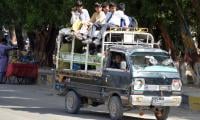UN Women is all set to mark 16 days of activism against gender-based violence but unfortunately it has failed to include violence against women in conflict zones within this agenda. Yet this is a critical aspect of violence against women and its impact on family and societal structures.
Ironically, given the recent scandals that have emerged regarding abuse of women in conflict areas by UN peacekeepers, UN Women should have focused on gender-based violence in conflicts, especially unconventional conflicts involving state and non-state actors.
Conflict situations always create risks for women, particularly in the context of abuse and exploitation, both directly, where women are specifically targeted, and indirectly because conflict leads to a breakdown in the structure of the family. So conflicts, especially unconventional ones, destroy the core group of society – the family. And it can take decades after the conflict is over to recover from this destruction. Ever since the centre of gravity of wars – conventional and unconventional – shifted from the armed forces to civilian populations, women and children have become part of the targeting strategies. Yet in processes aimed at ending wars and resolving conflicts, women have been left out of the mainstream of stakeholders involved in peace making.
In October 2000, the UN Security Council adopted Resolution 1325 on “Women, Peace and Security”, which recognised the need to understand the consequences of armed conflict on women and girls so that institutional arrangements could be developed and strengthened to guarantee not only their safety but also the participation of women in the peace process. Of course, different regions of the world produce their own unique problems and needs relating to women in conflict areas. The ICRC, recognising this, stated in a report following UNSC Resolution 1325 that “the effect of war on women is not only determined by the character and stage of the conflict, but also by the particular role of each woman caught up in it”. In other words, “it is vital to respond to women’s particular needs – be they combatants, persons deprived of their freedom, refugees, IDPs, mothers and/or members of the civilian population”.
In Indian Occupied Kashmir (IOK), women have been severely affected by the struggle against Indian occupation, but women have remained outside of the political dialogues so that their specific issues and concerns are denied the centrality they deserve. For instance, although Kashmiri women have become deliberate targets of the Indian security forces through the use of rape as a weapon of war, they are yet to come to the forefront as primary stakeholders in any discussion on conflict resolution.
The International Criminal Tribunals of Yugoslavia and Rwanda (ICTY and ICTR) first highlighted the concept of rape as a weapon of war, and rape has been systematically and persistently used by the Indian army against Kashmiri women. One reason why this has kept recurring is because of the culture of impunity that prevails. For instance, in May 1990, a young woman, Mubina Gani, was raped. An inquiry was conducted which found that the rape had indeed occurred but the officials responsible were never prosecuted. A few months later, in July 1990, a case was registered against Border Security Force officials for the rape of a 24-year old woman, Hasina. No investigation was carried out in this case, let alone prosecution.
Who can forget the horrific rape of a young girl in a temple in IOK by Indian security forces? Nor has it been just individual cases of rape by individual Indian security personnel. There were the two incidents of mass rape committed by Indian soldiers in the villages of Poshpora and Kunan in February 1991 when Indian security forces entered the villages and separated the men from the women before proceeding to rape the latter. Although the survivors have been fighting for justice in the Indian courts, so far justice has eluded them.
Such impunity is systemic as was highlighted in 2013 by Rashida Manjoo, the Special Rapporteur on Violence against Women, its Causes and Consequences. She noted how the Armed Forces (Special Powers) Act and the Armed Forces (Jammu and Kashmir) Special Powers Act 1990 granted special powers to the Indian security forces, which resulted in a lack of accountability and redress for victims of human rights violations. She especially emphasised how the Army Act 1950 “limits the scope for civil courts to consider allegations of violence against women perpetrated by army officials, including killings and sexual violence”.
However, women also suffer indirectly in conflict situations because, when the male breadwinner is no longer alive, female-headed households face innumerable challenges of survival, which impacts the education and health of the entire family. It is in this context that the issue of ‘enforced disappearances’ becomes critical – especially because there is no closure for the family. That is why when states move towards democracy from authoritarianism, not only must enforced disappearances end – for families to have closure – but some form of a truth and reconciliation commission must also be created to bring closure to families.
In fact enforced disappearances, especially where special draconian powers are given to the LEAs and the military, as has been the case in IOK, are also a major source of the victimisation and psychological torture of families (This issue requires a separate article or paper, which will soon be forthcoming in a wider context beyond Kashmir). Again, in Kashmir the issue of enforced disappearances has led to the creation of the term ‘half widows’ – women whose husbands have disappeared but have not been declared deceased. These ‘half widows’ tend to live impoverished lives, confronted with socio-economic and psychological uncertainties such as lack of property rights and the right to remarry.
However, if the Indian occupation security forces had calculated that the targeting of women would result in a loss of will on the part of the Kashmiris to continue their struggle for liberation from Indian Occupation and demand their right to self determination, their calculations could not have been more erroneous. Women in Kashmir have fought back against the violence perpetrated against them – since 2014, on every February 23, ‘Kashmiri Women’s Resistance Day’ is commemorated as this was the day on which the mass rape and torture of women was carried out after a large-scale military attack in the villages of Poshpora and Kunan.
Unfortunately, not enough attention is focused on the gender dimension of the violence being perpetrated by the Indian occupation forces in IOK. Issues of sexual violence, trafficking, enforced prostitution, children born as a consequence of sexual violence and suffering trauma and stigmatization – all these are the fallout from the human rights abuses and violations of international humanitarian laws by the Indian state. Pakistan has failed to raise these issues in international organisations dealing specifically with women in conflict situations as it seeks international support for implementation of UNSC resolutions on Kashmir. As for the democratic world, for all its claims to upholding human rights values, it has been criminally silent on Indian atrocities in IOK, especially the use of rape as a deliberate weapon of war by Indian security forces.
The writer is the federal minister for human rights.
Twitter: @ShireenMazari1
A health worker administers polio vaccine drops to a child during a door-to-door polio vaccination campaign in Lahore,...
Armed militants of the banned Tehreek-e-Taliban Pakistan pose for a photograph in Orakzai Agency. —...
An aeroplane of the national flag carrier of Pakistan is seen in this file photo. — AFPWhile Pakistan considers...
Representational image of a graph depicting various variables. — APP/FileInitiated by the centre and fiercely...
In this picture taken on April 16, 2023, people throng a market area during shopping in Lahore. — AFPOne of the...
Honour crimes also target men. In Sikandar Ali Lashari vs The State, SHC upheld conviction passed by ATC for honour...







